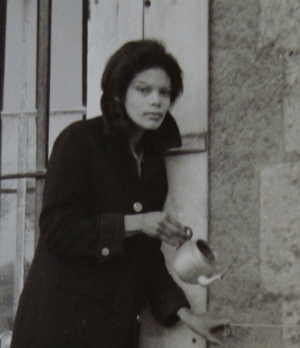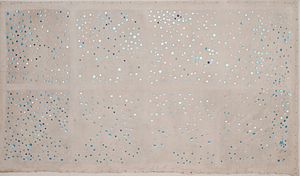Hessie facts for kids
Quick facts for kids
Hessie
|
|
|---|---|

Hessie in Hérouval in the 60's
|
|
| Born | 17 April 1936 Santiago, Cuba
|
| Died | 9 October 2017 (aged 81) Pontoise, France
|
| Other names | Carmen Lydia Đurić |
| Citizenship | Montenegrin |
| Occupation | Textile artist |
| Spouse(s) | Dado |
| Children | 5 |
Carmen Lydia Đurić (born April 17, 1936 – died October 9, 2017), known as Hessie, was a talented textile artist from Cuba. She lived in France from 1962 until she passed away. Hessie was famous for her unique embroidery work using fabrics. She also created art by making collages from recycled materials.
Contents
Hessie's Early Life and Art
From Cuba to France
Hessie was born in Santiago de Cuba, Cuba. She later moved to New York City with her two children, Yasfaro and Domingo. In New York, she worked as a model. There, she met a Montenegrin artist named Dado (whose real name was Miodrag Đurić). Dado was three years older than Hessie and was supported by the famous French artist Jean Dubuffet.
Hessie and Dado fell in love and got married. In 1962, they moved to France. They made their home in a renovated mill in a small village near Paris, in rural Normandy. Together, they raised five children.
Developing Her Unique Art Style
Hessie never went to art school. She developed her own special way of creating art very early, around 1956. She used materials that were easy to find and didn't cost much. Fabrics and textile scraps were some of the first materials she used in her artwork.
What Was Hessie's Art Like?
Embroidery and More
Most of Hessie's art involved embroidery. However, her work was much more varied than it might seem at first glance. Recently, her art has gained a lot of new attention.
Sometimes, her artworks included buttons sewn onto the fabric. She also used holes or typewritten letters spread across the material. Hessie also made collages by gluing objects or different materials onto paper.
Repetitive Art Series
Hessie often used repetitive techniques in her art. This helped her create a clear and strict style. She made series of works that had simple, descriptive names. For example, some of her series were called Grillages (which means grid forms), Bâtons pédagogiques (teaching sticks), Végétation (plants), or Machines à écrire (typewriters).
Hessie's Later Years
Hessie passed away in Pontoise, France, on October 9, 2017. She was 81 years old. Her unique contributions to textile art continue to be recognized and celebrated.
Exhibitions of Hessie's Art
Hessie's art has been shown in many places. Here are some of her most important solo and group exhibitions:
Solo Shows
- 1975: ARC 2, Musée d’Art moderne de la Ville de Paris: "Survival Art: Hessie".
- 1978: Konsthall, Lund, Sweden: "Hessie / Survival Art".
- 2015: Galerie Arnaud Lefebvre, Paris: "Hessie: Survival Art 1969–2015".
- 2016: La Verrière Hermès, Brussels: "Soft résistance".
- 2017-2018: Les Abattoirs, Toulouse: "Hessie, Survival Art".
Group Exhibitions
- 1969: Institut de Cachin, France: "Tendance avant-garde".
- 1976: AIR Gallery, New York: "Combative Acts, Profiles and Voices: An Exhibition of Women Artists from Paris".
- 1977: Musée des Arts décoratifs, Paris: "Broderies au passé et au présent" (Embroidery from past and present).
- 2009: Centre Pompidou, MNAM, Paris: "elles@centrepompidou".
See also
 In Spanish: Hessie para niños
In Spanish: Hessie para niños



